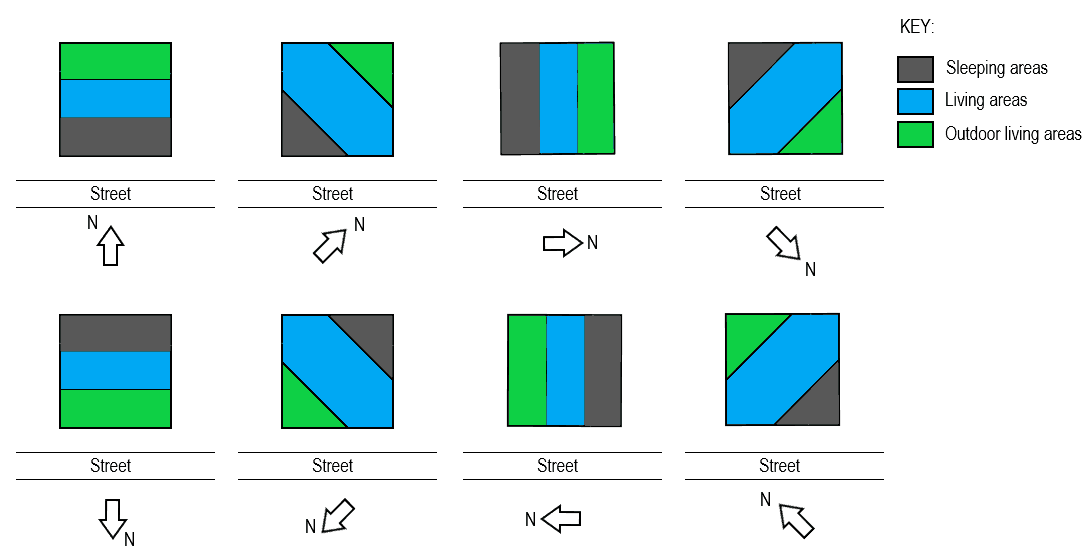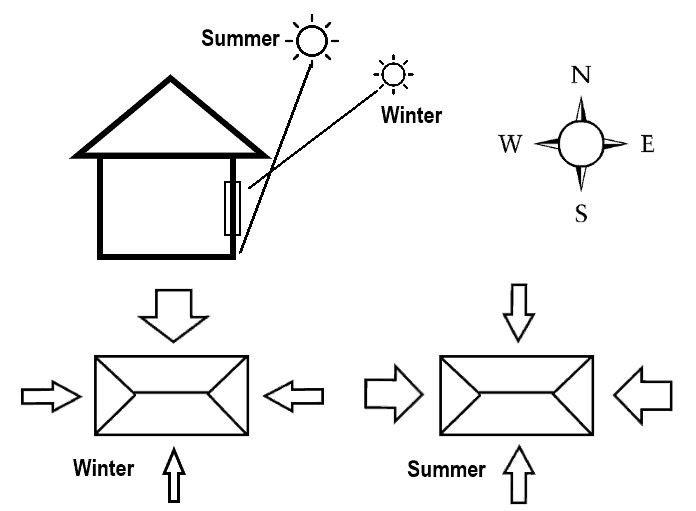Proper house orientation is important to get optimal solar heating, shading, and cooling. When you position your house or building, it should take advantage of the seasonal solar exposure as well as the climate in your area. Therefore, you need to know the suns path in different seasons, understand appropriate design, and make it efficient for more affordable utility costs.
How to Determine the Best House Orientation
So, how do you identify which is the best direction your living areas should face?
Orienting a house to harness the warmth of the sun in winter and at the same time avoiding too much heat during summer is not a new concept for homeowners. In fact, ancient Roman and Greek homes were positioned and built while considering seasonal sun exposure.
Which Direction Should My Living Room Face?
Certain factors that influence house orientation never change. For instance, sunrise is in the east and sunset is in the west. With this basic knowledge, you can easily understand how to position your home in a certain way to use seasonal movements to reduce heating or cooling costs while increasing indoor comfort all year round.

Best House Position for the Sun: East and West Axis
Building your house along east and west axis is the most ideal was to get warmth from the sun in winter and minimal sun in summer. Homes that are built to take advantage of this are usually rectangular in form to increase northern sun exposure in winter.
It is ideal for the eastern and western sides of the design to be the smaller sides compared to the northern and southern dimension. Additionally, in order to create a thermal buffer zone that will protect your home from infiltration during cold winds, not commonly used parts like the garage and laundry room should be located in the short end of your house.

The most commonly used parts of the house should be on the long north side. These parts will take advantage of more sunlight and solar warmth during winter for lower lighting costs.
Which Direction Should Windows Face
The longer, north facing house side should have windows positioned to serve as sunlight collectors that provide warmth to your home during winter. However, cooling and heating shortfalls will occur often if the house orientation is farther from a 20-degree angle of south.
For houses that are built with larger windows facing west and east, for instance, may experience too much heat during hot months and are the most difficult to shade. So, try to avoid these.
Windows facing west are usually bombarded by too much heat as the sun sets in summer while they only give little heating in winter months. Always consider seasonal movements when designing your home so you will feel comfortable no matter the season.
Wind Directions in Perth
There should be an allowance for southern facing windows as well. This will permit cross ventilation throughout the house. The advantage of this is you can open up the windows in late afternoon when it has cooled down to allow the breeze to move through the house and flush out the hot air.

In Perth, Western Australia, the sea breeze known as the “Fremantle doctor” comes from the SW direction and your house design can cater for this by having some South West openings.
Landscape Features to Cool Your Home
When it comes to natural aesthetics, you can take advantage of the landscape features for your location. Orient your house to the direction where there are broad-leaved trees that can reduce heat and provide enough shading from intense summer heat.
However, make sure that the trees can still allow sun exposure even if they defoliate during cold months. Evergreen trees and rolling hills on the north may help guard against cold winds in winter.
Benefits of Having the Best House Orientation For Your New Home
If your house is positioned to benefit from seasonal movements such as cooling breezes and warm sun, you can enjoy more comfort while paying for lower utility costs and may be able to forget the air con making your house cost less. But aside from that, there are more advantages you can get from the best house orientation.
Australian homes that are properly positioned can take advantage of the solar and wind energy provided by nature. More well-oriented homes should be designed to reduce energy consumption. Houses can get maximum northern sunlight with less radiant heat because of louvers, external blinds, and trees.
House orientation is associated with energy efficiency. It’s not difficult to see why poorly oriented homes need ceiling fans and air conditioning units to keep the rooms cool, which is not energy efficient. Good orientation provides natural lighting for rooms that are facing north.
During summer, thermal comfort is most important for house occupants especially the elderly who are vulnerable to weather related illnesses.
Why Consider a House Orientation Before Buying a Property?
It’s an important thing to consider house orientation before buying a house, apartment, or property because of the cooling and warming needs of home. If you will depend on air condition units and a heater to keep you comfortable throughout the seasons, that will give you high energy usage which means high monthly bills.
Make sure to ask your architect or builder to design with the solar principles in mind to make sure the exact design that will suit the location. The design should optimize positioning to avoid heat loss during winter and overheating during summer.
If the house doesn’t have external shading, an option is to put tinted windows. However, this will prevent heat gain during winter, which is really important in cold months so be aware of this.

Written by Kyle S.
Kyle is a qualified draftsman and civil engineer with a passion for building.


Hi Carol, Quite a hard question without seeing the plan. If you are aiming to get sun in the northern rooms in winter a roofed courtyard might block out the sun getting in to the rooms on the northern side so something to consider.
Thanks Kyle, appreciate the feedback. Think I’ll open up courtyards on both sides of the house, (narrow block of just under 10 m, street front facing North). Not necessarily solar gain in winter given the low angle but at least sunlight!!